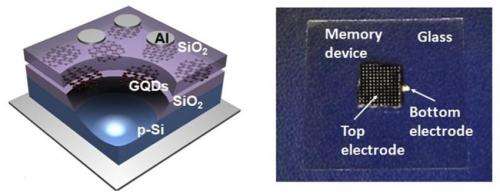June 18, 2014 feature
Graphene quantum dot flash memories look promising for data storage

(Phys.org) —Today's commercial flash memories usually store data as electric charge in polysilicon layers. Because polysilicon is a single continuous material, defects in the material can interfere with the desired charge movement, which can limit data retention and density.
To overcome this problem, researchers have recently been working on storing charge in discrete charge traps, such as nanocrystals, instead of polysilicon layers. Since discrete charge trap materials have the advantage of preventing unwanted charge movement as a result of their lower sensitivity to local defects, they offer the potential for high-density flash memories.
Now in a new study, scientists have used graphene quantum dots instead of nanocrystals as the discrete charge trap material. The researchers, Soong Sin Joo, et al., at Kyung Hee University and Samsung Electronics, both in Yongin, South Korea, have published their paper on graphene quantum dot flash memories in a recent issue of Nanotechnology.
Although graphene in general is widely known as an attractive material for next-generation electronics and photonics because of its unique properties, the development of graphene memory devices is still at an early stage. Graphene quantum dots in particular are very new materials. As bits of graphene extracted from bulk carbon, graphene quantum dots can be engineered with specific electronic and optical properties for different purposes.
Here, the researchers prepared graphene quantum dots of three different sizes (6, 12, and 27 nm diameters) between silicon dioxide layers. The researchers found that the memory properties of the dots differ depending on their sizes. For instance, while the 12-nm dots exhibit the highest program speed, the 27-nm dots exhibit the highest erase speed, as well as the highest stability.
"This is the first report of charge-trap flash nonvolatile memories made by employing structurally characterized graphene quantum dots, even though their nonvolatile memory properties are currently below the commercial standard," coauthor Suk-Ho Choi at Kyung Hee University told Phys.org. "Actually, this is first successful application of graphene quantum dots in practical devices, including electronic and optical devices, as far as I know, even though there are many reports on physical and chemical characterizations of graphene quantum dots."
As flash memory devices in their early stages of development, the graphene quantum dot memories demonstrate a promising performance, with an electron density comparable to that of memory devices based on semiconductor and metal nanocrystals. The researchers hope that future improvements to the devices will lead to enhanced performance and new applications.
"If flexible dielectrics (insulators) are used instead of silicon dioxides as tunnel and control barriers on plastic substrates, then they can be used in flexible (or wearable) electronic devices," Choi said. "Metal nanoparticles also offer several advantages similar to graphene quantum dots, such as higher density of states, flexibility in choosing the work function, etc., for charge-trap flash nonvolatile memories, but may potentially degrade the device performance due to their thermal instabilities and are not useful for transparent and flexible electronics and photonics."
More information: Soong Sin Joo, et al. "Graphene-quantum-dot nonvolatile charge-trap flash memories." Nanotechnology 25 (2014) 255203 (6pp). DOI: 10.1088/0957-4484/25/25/255203
Journal information: Nanotechnology
© 2014 Phys.org



















